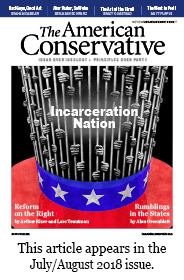Today's youth are lonely, adrift, and politically disengaged.
By • August 13, 2018

Credit: Syda Productions/Shutterstock
Forget the Baby Boomers, Generation X, and the Millennials. The latest generation to come under the media microscope is “Generation Z.” Typical of mainstream coverage of Generation Z is a recent Washington Post opinion piece telling us, “Millennials disrupted the system. Gen Z is here to fix the mess.”

I’m not so sure.
Generation Z is the population cohort born from the mid-1990s to 2010,estimated to be larger than surviving Baby Boomers and comprising about a quarter of the population. Generation X is loosely defined as those born between 1965 and 1980. Millennials, next in line, are part of the 1981-1996 population tier. These designations, though, are flexible, overlapping, and sometimes contradictory.
On the basis of what information we have, however, Generation Z isn’t likely to “fix” any political “mess.” A recent Harvard poll of young Americans between the ages of 18 and 29 found that, while three quarters of them claimed to be registered to vote, a massive 70 percent said they were “not politically engaged or politically active.” As for prospects of a Generation Z-led “Blue Wave” in this November’s midterm elections, even billionaire liberal activist Tom Steyer, who has committed $31 million to turn out the youth vote, concedes that recent history isn’t on his side. In the last midterms (2014), only 15 percent of eligible 18- to 20-year-olds bothered to vote. When it comes to politics, Generation Z may be Generation Zzzz.
While Democratic politicians and left-wing activists still hope to exploit recent school shootings to energize this apathetic voting bloc, their efforts to date haven’t been successful. Despite the use of cadres of paid organizers and free transport, the much-heralded “March for Our Lives” in Washington, D.C., on March 24 failed to live up to its own expectations. Organizers set a goal of half a million and afterwards claimed a turnout of 850,000. CBS News reported, however, that a digital imaging analysis using aerial photos revealed that the real peak attendance was only about 202,796.
And consider the findings of Professor Dana R. Fisher of the University of Maryland’s Sociology Department. She headed a research team that attended the rally and interviewed a statistical sampling of marchers. Her findings? Less than 10 percent of the crowd was under 18, while “the average age of the adults participating was higher than at any other event that I have studied since the Resistance began after Donald Trump’s Inauguration.” And since only 16 percent of marchers identified themselves as “moderates,” many more of them may have been aging Bernie Sanders fans rather than newly engaged members of Gen Z.
Part of the reason could be that the Z cohort is not all that into organized group activities and has spent too much time glued to electronic devices and too little time interacting with fellow humans. A Cigna Health study released this past May found that Generation Z represented the loneliest cohort of Americans. Interestingly, Americans over 72—including members of the so-called “Greatest Generation”—were the least lonely, despite the infirmities of age and the toll of mortality. Washington Times reporter Laura Kelly explains that the Americans of Generation Z have displayed “key social behavior patterns…predictive of increased feelings of loneliness.” She adds that these include “less frequent and meaningful in-person interactions; spending less time with family and the feeling of having poor social skills or relationships.”
Sadly, this could help explain much of the causation behind recent school shootings, almost always carried out by Generation Z killers targeting Generation Z victims. The same social deficiencies that make Generation Z lonely may, at a more chronic level, be one of the driving factors behind Generation Z mass killings, many if not most of which have been perpetrated by people from broken homes, often identified as alienated and potentially dangerous long before they turned violent. All of which leads us to the question of how Generation Z got to what most would agree is a rather bad place.
What’s different now? It certainly isn’t large classroom size, a favorite excuse used by the education lobby. In the public school classes I attended throughout the 1950s, there were always more than 30 students per class, and yet school discipline was never a problem. Why? For one thing, there were few if any feral students. From kindergarten on up, students entered the classroom with a modicum of self-control and basic social skills acquired at the hands of parents and siblings in stable families living in civilized neighborhoods.
Religion still played a positive role in most families, and divorce was a relative rarity, as was illegitimacy. Drug use was virtually unknown, and the pop culture as purveyed by Hollywood, television, and the music industry avoided the obscene, the morbid, the treasonous, and the blasphemous. Another big difference was the fact that most of the money was still in adult hands. Teen and pre-teen spending was only beginning to pick up with postwar affluence. The grown-ups were still in charge.
Less and less so today. We may have reached the point anticipated in the old Noël Coward song that asked, “What’s going to happen to the children when there aren’t any more grownups?”
The answer, for better or worse, may be Generation Z.
Aram Bakshian Jr. is a former aide to presidents Nixon, Ford, and Reagan. His writings on politics, history, gastronomy, and the arts have been widely published in the United States and abroad.
https://www.theamericanconservative.com/articles/generation-z-or-generation-zzzzz/

0 Comments:
Post a Comment
Subscribe to Post Comments [Atom]
<< Home